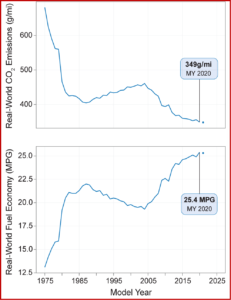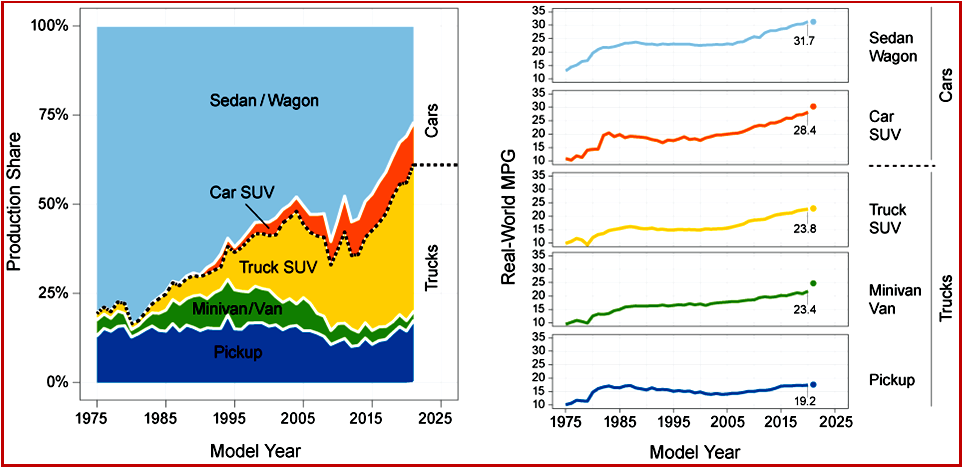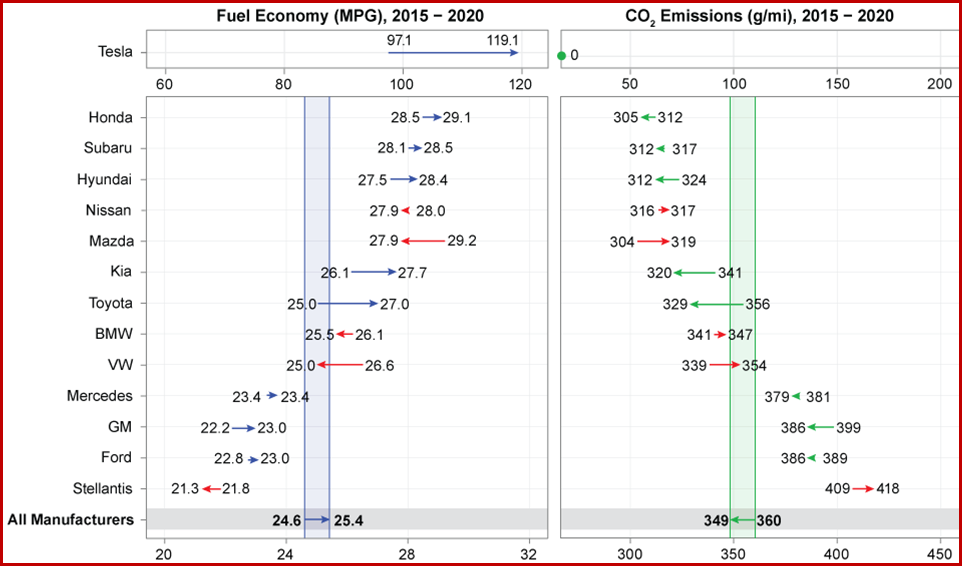
More good public policy is coming! Click to Enlarge.
The U.S. Environmental Protection Agency released its annual Automotive Trends Report today which shows model year 2020 vehicles achieved record high fuel economy and record low emission levels. Large automakers also were in full compliance with greenhouse gas emission standards. EPA Projections indicate sales of hybrid and electric vehicles will more than double from 2020 to 2021 – the latest reason, as if any more were needed, to pass Build Back Better.
In August, President Biden signed an Executive Order that sets good policy for US citizens with an ambitious new target to make half of all new vehicles sold in 2030 zero-emissions vehicles, including battery electric, plug-in hybrid electric, or fuel cell electric vehicles. EPA also proposed a new rulemaking under the Clean Air Act that by 2026 would establish the strongest greenhouse gas emission standards for cars and light duty trucks in history.

The new vehicle market continues to move away from the sedan/wagon vehicle type towards a combination of truck SUVs and car SUVs. Truck SUVs reached a record 39% of the market in model year 2020, and car SUVs reached a record 13% of the market. The trend away from sedan/wagons, which remain the vehicle type with the highest fuel economy and lowest CO2 emissions, and towards vehicle types with lower fuel economy and higher CO2 emissions has offset some of the fleet-wide benefits that otherwise would have been achieved from the improvements within each vehicle type.
“Today’s report is a great indicator that automakers are following through with their promise of achieving clean car standards while providing consumers with great vehicle options,” said EPA Administrator Michael S. Regan. “I am optimistic that the innovation and marketing power of the auto industry, coupled with President Biden’s unprecedented support for a zero emissions future, will accelerate cleaner technologies, sharply cutting pollution to meet the climate challenge.”
Highlights
- Since model year 2004, carbon dioxide (CO2) emissions have decreased by 24% as fuel economy has increased by 32%.
- CO2 emissions for the average 2020 model year vehicle fell to 349 grams per mile (g/mi), the lowest ever measured, and seven g/mi lower than the average for model year 2019.
- Average Fuel Economy for model year 2020 vehicles increased to a record 25.4 miles per gallon, 0.5 mpg more than the average for model year 2019.
- Hybrids, plug-in hybrids, and electric vehicles are primed to grow, but are currently at low adoption levels. Electric and plug-in hybrid vehicles accounted for 2% of all production, and hybrids 5%. In the projected model year 2021 data, those categories are estimated to grow to 4% and 9% of all production.

Five manufacturers increased new vehicle CO2 emissions between model years 2015 and 2020. Volkswagen and Mazda tied for the largest increase at 15 g/mi. Volkswagen achieved reductions in CO2 emissions in both sedan/wagon and truck SUVs vehicle types; however, that was more than offset by a reduction in their production share of sedan/wagons, from 79% to 40%, and a corresponding increase in truck SUVs from 19% to 58%. Mazda was similar. A drop in sedan/wagon production share from 57% to 24%, a corresponding increase in car and truck SUV production share, and an increase in sedan/wagon CO2 emissions offset reductions in CO2 emissions from both car SUVs and truck SUVs.

About Ken Zino
Ken Zino, editor and publisher of AutoInformed, is a versatile auto industry participant with global experience spanning decades in print and broadcast journalism, as well as social media. He has automobile testing, marketing, public relations and communications experience. He is past president of The International Motor Press Assn, the Detroit Press Club, founding member and first President of the Automotive Press Assn. He is a member of APA, IMPA and the Midwest Automotive Press Assn.
He also brings an historical perspective while citing their contemporary relevance of the work of legendary auto writers such as Ken Purdy, Jim Dunne or Jerry Flint, or writers such as Red Smith, Mark Twain, Thomas Jefferson – all to bring perspective to a chaotic automotive universe.
Above all, decades after he first drove a car, Zino still revels in the sound of the exhaust as the throttle is blipped during a downshift and the driver’s rush that occurs when the entry, apex and exit points of a turn are smoothly and swiftly crossed. It’s the beginning of a perfect lap.
AutoInformed has an editorial philosophy that loves transportation machines of all kinds while promoting critical thinking about the future use of cars and trucks.
Zino builds AutoInformed from his background in automotive journalism starting at Hearst Publishing in New York City on Motor and MotorTech Magazines and car testing where he reviewed hundreds of vehicles in his decade-long stint as the Detroit Bureau Chief of Road & Track magazine. Zino has also worked in Europe, and Asia – now the largest automotive market in the world with China at its center.


2020 Vehicles Post Fuel Economy, Low Emissions Records
More good public policy is coming! Click to Enlarge.
The U.S. Environmental Protection Agency released its annual Automotive Trends Report today which shows model year 2020 vehicles achieved record high fuel economy and record low emission levels. Large automakers also were in full compliance with greenhouse gas emission standards. EPA Projections indicate sales of hybrid and electric vehicles will more than double from 2020 to 2021 – the latest reason, as if any more were needed, to pass Build Back Better.
In August, President Biden signed an Executive Order that sets good policy for US citizens with an ambitious new target to make half of all new vehicles sold in 2030 zero-emissions vehicles, including battery electric, plug-in hybrid electric, or fuel cell electric vehicles. EPA also proposed a new rulemaking under the Clean Air Act that by 2026 would establish the strongest greenhouse gas emission standards for cars and light duty trucks in history.
The new vehicle market continues to move away from the sedan/wagon vehicle type towards a combination of truck SUVs and car SUVs. Truck SUVs reached a record 39% of the market in model year 2020, and car SUVs reached a record 13% of the market. The trend away from sedan/wagons, which remain the vehicle type with the highest fuel economy and lowest CO2 emissions, and towards vehicle types with lower fuel economy and higher CO2 emissions has offset some of the fleet-wide benefits that otherwise would have been achieved from the improvements within each vehicle type.
“Today’s report is a great indicator that automakers are following through with their promise of achieving clean car standards while providing consumers with great vehicle options,” said EPA Administrator Michael S. Regan. “I am optimistic that the innovation and marketing power of the auto industry, coupled with President Biden’s unprecedented support for a zero emissions future, will accelerate cleaner technologies, sharply cutting pollution to meet the climate challenge.”
Highlights
Five manufacturers increased new vehicle CO2 emissions between model years 2015 and 2020. Volkswagen and Mazda tied for the largest increase at 15 g/mi. Volkswagen achieved reductions in CO2 emissions in both sedan/wagon and truck SUVs vehicle types; however, that was more than offset by a reduction in their production share of sedan/wagons, from 79% to 40%, and a corresponding increase in truck SUVs from 19% to 58%. Mazda was similar. A drop in sedan/wagon production share from 57% to 24%, a corresponding increase in car and truck SUV production share, and an increase in sedan/wagon CO2 emissions offset reductions in CO2 emissions from both car SUVs and truck SUVs.
Click to read the EPA Automotive Trends Report
About Ken Zino
Ken Zino, editor and publisher of AutoInformed, is a versatile auto industry participant with global experience spanning decades in print and broadcast journalism, as well as social media. He has automobile testing, marketing, public relations and communications experience. He is past president of The International Motor Press Assn, the Detroit Press Club, founding member and first President of the Automotive Press Assn. He is a member of APA, IMPA and the Midwest Automotive Press Assn. He also brings an historical perspective while citing their contemporary relevance of the work of legendary auto writers such as Ken Purdy, Jim Dunne or Jerry Flint, or writers such as Red Smith, Mark Twain, Thomas Jefferson – all to bring perspective to a chaotic automotive universe. Above all, decades after he first drove a car, Zino still revels in the sound of the exhaust as the throttle is blipped during a downshift and the driver’s rush that occurs when the entry, apex and exit points of a turn are smoothly and swiftly crossed. It’s the beginning of a perfect lap. AutoInformed has an editorial philosophy that loves transportation machines of all kinds while promoting critical thinking about the future use of cars and trucks. Zino builds AutoInformed from his background in automotive journalism starting at Hearst Publishing in New York City on Motor and MotorTech Magazines and car testing where he reviewed hundreds of vehicles in his decade-long stint as the Detroit Bureau Chief of Road & Track magazine. Zino has also worked in Europe, and Asia – now the largest automotive market in the world with China at its center.